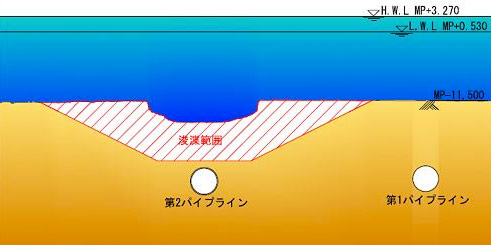Peter Kenyon, TunnelTalk
- A police investigation into the death of five workers who drowned during a subsea tunnel collapse in Japan has taken a step forward following recovery of the TBM and sets of concrete segmental lining.
-

Salvaged TBM on the deck of the recovery barge
- A specialist salvage team has raised the 4.82m diameter TBM from the 800m wide sea channel where it has been buried under a combined 26m depth of water and sand for more than 18 months since the 7 February 2012 accident.
- "The cause of the collapse is still not clear at this moment, which is why Okayama Prefecture Police, who are carrying out the investigation, ordered us to get the machine out of the water," said Sei Yokote, spokesman for the project's main contractor Kajima Construction. "The Kajima company paid for the recovery operation," he told TunnelTalk from Japan.
- The collapse is currently the subject of an ongoing police investigation into an allegation of possible corporate negligence, and neither Kajima, nor the client, petrochemical refinery company JX Nippon, would speculate about possible causes.
- JX Nippon, the largest petrochemical company in Japan, contracted Kajima to construct the tunnel for an undersea pipeline between two of its refineries on opposite sides of a sea channel at Mizushima Port in Kurashiki, west Japan (Fig 1, right). A spokesman for the company said JX Nippon was not part of the investigation adding that "the police are handling this with Kajima. Whether we decide to build another tunnel depends on the outcome of this investigation. We cannot consider it at this moment, it is out of our control."
-

Tunnel was to link refineries in the bottom left and top right of the picture
- Kajima spokesman Yokote said any decision about whether to continue on the existing heading, which was approximately 150m complete before the collapse, would be "made by the Client, but I don't think the same tunnel will be used."
- Yokote also confirmed the thickness of concrete segments used for the heading was 160mm for a tunnel i.d. of 4.5m.
- Recovery of the TBM was via a barge on the water surface. Recovery back through the flooded tunnel was considered too great a risk. A large-scale sinkhole above the accident site was identified by a Japanese Coast Guard survey vessel shortly after the accident took place. The existence of the sinkhole raised fears that the surviving part of the inundated tunnel might also be at risk of collapse. The exact location of the TBM was mapped prior to dredging using magnetic survey equipment.
- The recovery operation was completed on 24 August 2013 and involved dredging silt and sand from around the sinkhole that formed on the seabed as a result of the tunnel collapse. Dredging progressed to a depth of 10.5m below the seabed and to within a vertical distance of approximately 2m of the top of the TBM (Fig 2, right). Tunnel contractor Kajima said a total of 23,000m3 of material was dredged by salvage crews working to free the TBM, and that the operation was made more complicated by the proximity of a pipeline encased in a similar tunnel structure that was constructed in 2002 and is currently in service.
-

Sinkhole at accident site revealed by Coast Guard survey
- The next operational phase involved sinking 62 x 700mm diameter steel piles to a depth of 13.5m into the seabed and around the site of the buried TBM (Fig 3, right).
- Divers were then able to remove the remaining silt and sand around the TBM to a depth of approximately 7m below the upper height of the steel piles. All five bodies of the workers lost in the accident had been recovered within a week of the 2012 disaster. Sedimentary material from around the TBM was removed using a compressed airlift suction dredging system (Fig 4, right), leaving part of the flooded tunnel and the TBM clear of all silt and sand and surrounded by only water (Fig 5, right). Tunnel segments that may hold clues as to the possible cause of the accident were lifted first, using a ship crane. Once exposed by water on all sides, divers were able to secure cables and a platform for the TBM to be hoisted out of the water and onto a barge for transportation away for further investigation. The outcome of those investigations is yet to be reported, and neither the Kajima nor JX Nippon spokesmen were able to confirm to TunnelTalk that the conclusions will be made public.
- One worker survived the tragedy. He was working at the bottom of the 33m launch shaft when the inundation occurred, and the force of the water raised him to the surface.
-
Possible causes of Japan's fatal tunnel failure - TunnelTalk, March 2012
Five feared dead in Japanese tunnel collapse - TunnelTalk, February 2012
|
|
|
|
|
Add your comment
- Thank you for taking the time to share your thoughts and comments. You share in the wider tunnelling community, so please keep your comments smart and civil. Don't attack other readers personally, and keep your language professional.










